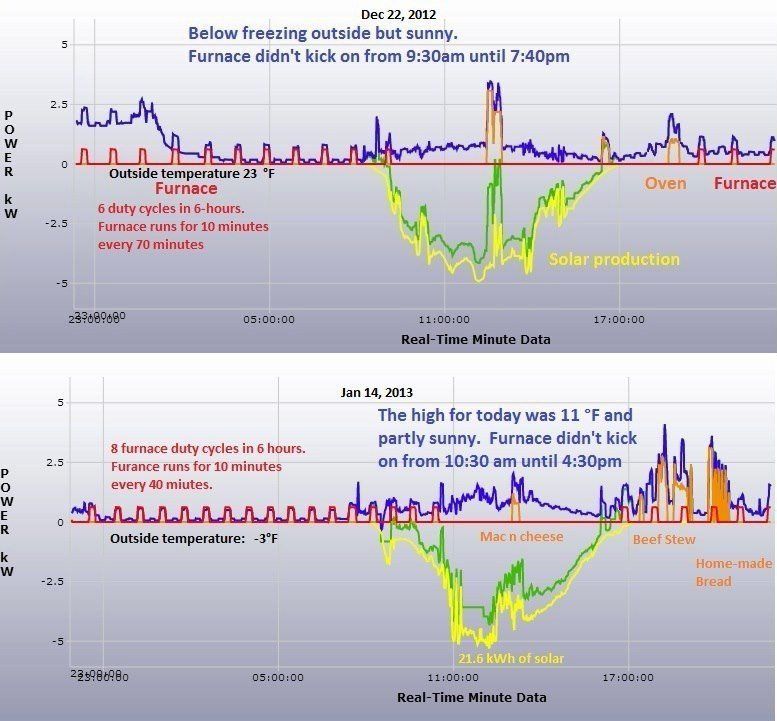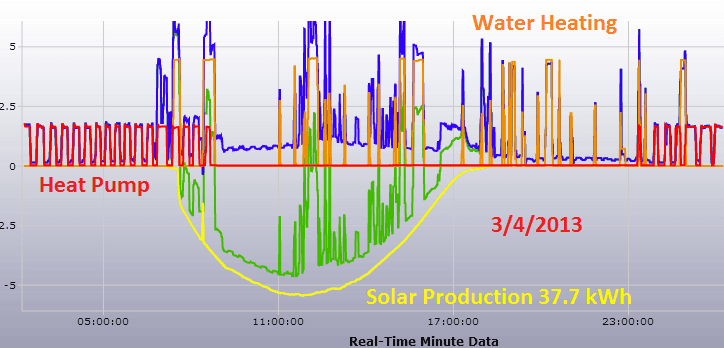Published Sunday March 3, 2013: Updated Sunday March 10, 2013
Heat pump Performance
It has been 2 weeks since we had our natural gas furnace, water heater and central air conditioner ripped out and replaced with a super efficient geothermal ground loop heat pump and electric water heater.
Our house has never felt so comfortable. The continual circulation does a wonderful job of keeping the temperature of the entire house constant.
Previously, under natural gas power, the daily energy consumption in the winter time was 2.2 kW-Hr in electricity per day (for the blower) and 3 therms of natural gas per day for home and water heating.
Converting these to the same energy unit, this is an equivalent energy usage of (29.3 kW-Hr per therm) 3 x 29.3 + 2.2 = 193 kW-Hr per day. Our gas furnace was only 80% efficient and the gas water heater was only 55% efficient. So if we were using a purely resistive electric furnace and water heater, they would require about 120 kW-Hr per day to heat our home and water.

Red: Electric duty-cycle for the blower in the original 135,000 BTU gas furnace in the winter months.

This is a graph of our home's energy usage for March 3, 2013. It was a very dark, cloudy day (with a high of 42 °F). Notice the yellow solar plot and how little energy was created? Notice how the heat pump (Red) cycled on and off all day. The geothermal equipment only draws about 1700 watts when running in stage 1. It draws 2600 watts in stage 2 (as seen briefly on the right side of the above picture).

By contrast to the picture above, here is a graph of my home's energy usage for March 4, 2013. It was a beautiful, cold, sunny day (with a high of 37 °F. The passive solar heating warmed the house all day. The heat pump didn't cycle on/off at all that day from 8:30 am until 11:20 pm. The heat pump only used 8.3 kWh of electricity that day. The water heater used 11.1 kWh of electricity that day (lots of baking and washing dishes).
In the last 2 weeks, the hot water heater has used an average of 8.2 kWh per day and the geothermal heat pump has used 15.2 kWh per day, (a 634 watt average power draw). With natural gas usage now zero (less the trivial amount still consumed by the gas clothes drier) the total additional electric usage is 23.4 kWh per winter day in heating energy.
Considering that 193 kWh per day in natural gas energy was being consumed before, 23.4 kWh is a huge gain in efficiency.
Even with factoring out the inefficiencies of natural gas and using the calculated resistive heating energy requirement of 120 kWh per day, the overall coefficient of performance (COP) is 5.1. The specified COP of this equipment is only 4.8. I attribute this extra performance to warmer than expected ground temperatures. Awesome!
Tweaks:
It took a few days for the installers to get the humidifier option working perfectly. But now that it is up and running, we keep the house at a very comfortable 40% humidity. With good insulation and air sealing, moisture buildup is not a problem. We even set the humidity up to 45% for a few days while one of our children had a cough. Breathing that air feels so good.
Symptoms of seasonally dry, cracking hands are also cured.
The humidifier gets its water supply from the hot water line. Initially the valve was set too high and lots of water was being wasted. I turned it down so now almost all the water going into the humidifier is evaporated and very little is lost wasted down the drain.
Even though the humidifier specifies to use the hot water line, I would like to experiment with running cold water instead, to see how that effects its performance and hot water energy consumption.
Bugs to still work out:
We are still getting used to having an electric water heater. Some days the water is hot and there is plenty of it. Other days the water is warm but not as hot as we like. I attribute this fickle performance to the super-deheater. It would be better if the super-deheater did all the hot water heating since it is 480% efficient vs the resistive element in the water heater which is 100% efficient.
When the sun is shining and the passive solar heating of the south-facing windows are warming the house, the compressor (and super-deheater) in the heat pump are both off. On a good sunny day, the bulk of the water heating (done by the super-deheater) does not happen for 6-15 hours until the thermostat calls for more heat. This isn't a malfunction. I think I just need to adjust the thermostats inside the water heater's resistive element during the different seasons.
In the spring and autumn, when it isn't too hot or too cold outside, the heat pump will hardly run and the domestic hot water heater will be supplying all the work heating the water. In this case, I will need to turn up the thermostat in the water heater.
In the summer time, I imagine the hot water heater will not be running at all, as the heat pump will have an overabundance of waste heat. During that time, I will need to turn down the thermostat in the water heater.
Regrets?
Absolutely none! we love the new equipment. Although, it was bad timing to make the change just as my energy credit with the power company was running out.
Heaven forbid that we have to start paying for electricity again. It's been nearly a year since we did that. Not that it's a big deal but it bugs me to be using so much extra electricity before the solar panels have had a chance to begin building up their energy credit again. Oh well, first world problems.
I hope to be back to net zero one year from now. I initially calculated that my existing, 6.2 kW solar array would be sufficient to provide all the energy to run everything, though I may have underestimated the amount of energy that it takes to heat domestic water (especially in the winter time when the temperature of tap water is only 48 °F, it's 66 °F in the summer time).
Of my own accord, I have stopped charging my EV up at work. This extra 16 kWh per week from supplying all my electric car charging from home, plus the added 22.6 kWh per day for heating all adds up to an extra 726 kWh per month during the winter months. Time will tell if we still end up at net zero.
